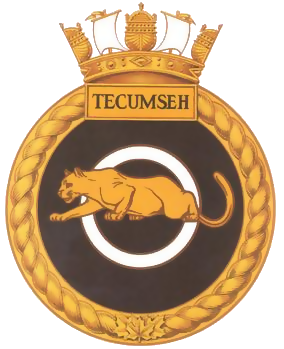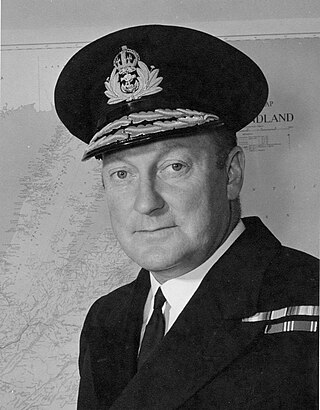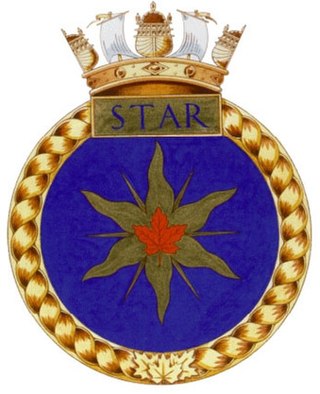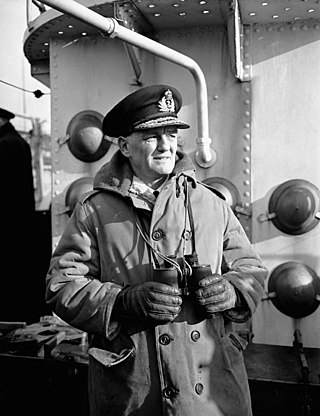
The Royal Canadian Navy is the naval force of Canada. The RCN is one of three environmental commands within the Canadian Armed Forces. As of 2023, the RCN operates 12 frigates, four attack submarines, 12 coastal defence vessels, eight patrol-class training vessels, two offshore patrol vessels, and several auxiliary vessels. The RCN consists of 8,400 Regular Force and 4,100 Primary Reserve sailors, supported by 3,800 civilians. Vice-Admiral Angus Topshee is the commander of the Royal Canadian Navy and chief of the Naval Staff.
The history of the Royal Canadian Navy goes back to 1910, when the naval force was created as the Naval Service of Canada and renamed a year later by King George V. The Royal Canadian Navy (RCN) is one of the three environmental commands of the Canadian Forces. Over the course of its history, the RCN has played a role in the First World War, contributed significantly to the Battle of the Atlantic during the Second World War, and was a part of NATO's force buildup during the Cold War. In 1968, the RCN was amalgamated with the Canadian Army and the Royal Canadian Air Force to form what is today the unified Canadian Armed Forces. The naval force was known as Maritime Command until 2011, when the environmental command was renamed as the Royal Canadian Navy.

Canadian Forces Base (CFB) Halifax is Canada's east coast naval base and home port to the Royal Canadian Navy Atlantic fleet, known as Canadian Fleet Atlantic (CANFLTLANT), that forms part of the formation Maritime Forces Atlantic (MARLANT).

HMCS Discovery is a Royal Canadian Navy Reserve division and shore facility based in Vancouver, British Columbia, Canada. Created during World War II from the Vancouver Half Company of the Royal Naval Canadian Volunteer Reserve, it was used for recruitment and training, and provided almost 8,000 personnel during the war. It continued its training role after the war, and is also headquarters for several Reserve and Cadet units.

HMCS Tecumseh is a Canadian Forces Naval Reserve division (NRD) located in Calgary, Alberta. Dubbed a stone frigate, HMCS Tecumseh is a land-based naval training establishment crewed by part-time sailors and also serves as a local recruitment centre for the Royal Canadian Navy (RCN). It is one of 24 naval reserve divisions located in major cities across Canada.
His Majesty's Canadian Ship (HMCS) Prevost is a Canadian Forces Naval Reserve Division (NRD) located in London, Ontario. Dubbed a stone frigate, HMCS Prevost is a land-based naval establishment for training part-time sailors as well as functioning as a local recruitment centre for the Royal Canadian Navy (RCN). Prevost reserve sailors serve on all classes of ship on both coasts and the Great Lakes and have served on many occasions overseas on UN and NATO tours of duty, along with harbour defence units.

Rear Admiral Leonard Warren Murray, CB, CBE was an officer in the Royal Canadian Navy who played a central role in the Battle of the Atlantic, and was the only Canadian to command an Allied theatre of operations during World War II.

Canadian Forces Base Cornwallis is a former Canadian Forces Base located in Deep Brook, Nova Scotia.
HMCS Kapuskasing was an Algerine-class minesweeper that served in the Royal Canadian Navy during the Second World War. The vessel was primarily used as a convoy escort in the Battle of the Atlantic. Following the war she saw service as a hydrographic survey ship with the Department of Mines. She was named for Kapuskasing, Ontario.
HMCS Sault Ste. Marie was a reciprocating engine-powered Algerine-class minesweeper built for the Royal Canadian Navy during the Second World War. Entering service in 1943, the minesweeper was used as a convoy escort in the Battle of the Atlantic. Following the war, the minesweeper saw service as a training vessel before being scrapped in 1960.

HMCS Charlottetown was a River-class frigate that served with the Royal Canadian Navy (RCN) during the Second World War. She was the second vessel of the name, HMCS Charlottetown having been a Flower-class corvette that had been sunk earlier in the war. They are unique for being the only two ships to have shared the same pennant number, K 244. She was named for Charlottetown, Prince Edward Island.
Rear-Admiral William Moss Landymore, OBE, CD was a Canadian naval officer. Born in Brantford, Ontario, Landymore joined the Royal Canadian Navy in 1936, but spent much of early career training with the Royal Navy. During World War II, Landymore returned to the Royal Canadian Navy and served aboard destroyers in the Battle of the Atlantic, surviving two sinkings. By the end of the war Landymore had taken a series of positions in Ottawa before returning to destroyer command during the Korean War. He was promoted through the ranks eventually becoming the first Commander of Maritime Command. :andymore became embroiled in a public feud with the Minister of National Defence following the Unification of the Canadian Armed Forces and resigned as a result. He died at Halifax, Nova Scotia.

HMCS Star is a Canadian Forces Naval Reserve Division (NRD) located in Hamilton, Ontario. Dubbed a stone frigate, HMCS Star is a land-based naval establishment for training part-time sailors as well as functioning as a local recruitment centre for the Royal Canadian Navy (RCN). The second oldest of 24 naval reserve divisions located in major cities across Canada, Star was stood up on 15 March 1923 as the Royal Canadian Naval Volunteer Reserve (RCNVR) Hamilton Half Company and then on 1 November 1941 as HMCS Star.

HMCS Malahat is a Royal Canadian Navy Reserve Division (NRD) located in Victoria, British Columbia. Dubbed a stone frigate, HMCS Malahat is a land-based naval training establishment for part-time sailors as well as a local recruitment centre for the Canadian Naval Reserve. It is one of 24 naval reserve divisions in major cities across Canada.

Vice-Admiral Harold Taylor Wood Grant, was a Canadian naval officer and a post-war Chief of the Naval Staff. The son of Lieutenant Governor of Nova Scotia, MacCallum Grant, Harold Grant entered the Royal Canadian Navy as a cadet in 1914. He spent most of the First World War in training until 1917, when he became a midshipman aboard a British Royal Navy ship. Considered an above average officer, he was earmarked for early promotion during the interwar period and by 1938, commanded the destroyer HMCS Skeena.

HMCS Montcalm is a reserve unit of the Royal Canadian Navy based in Quebec City, Quebec. As with all Naval Reserve divisions, its approximately 150 sailors specialize in domestic emergency readiness, port inspection diving, naval intelligence, and the recruiting and retention of personnel who supplement the Royal Canadian Navy on board ship and at shore establishments.

Vice-Admiral George Clarence Jones, was a Royal Canadian Navy vice admiral who served as Chief of the Naval Staff from 15 January 1944 to 28 February 1946.

HMCS Hunter is a Canadian Forces Naval Reserve Division (NRD) located in Windsor, Ontario. Dubbed a stone frigate, HMCS Hunter is a land-based naval training establishment crewed by part-time sailors and also serves as a local recruitment centre for the Canadian Forces Naval Reserve. It is one of 24 naval reserve divisions located in major cities across Canada.
HMCS Cataraqui is a Canadian Forces Naval Reserve Division (NRD) located in Kingston, Ontario. Dubbed a stone frigate, HMCS Cataraqui is a land-based naval establishment for part-time sailors as well as a local recruitment centre for the Royal Canadian Navy (RCN). It is one of 24 naval reserve divisions located in major cities across Canada.

Navy bands in Canada are part of the Royal Canadian Navy's command structure and overseen by the Music Branch of the Canadian Forces and the Directorate of History and Heritage of the Department of National Defence.























